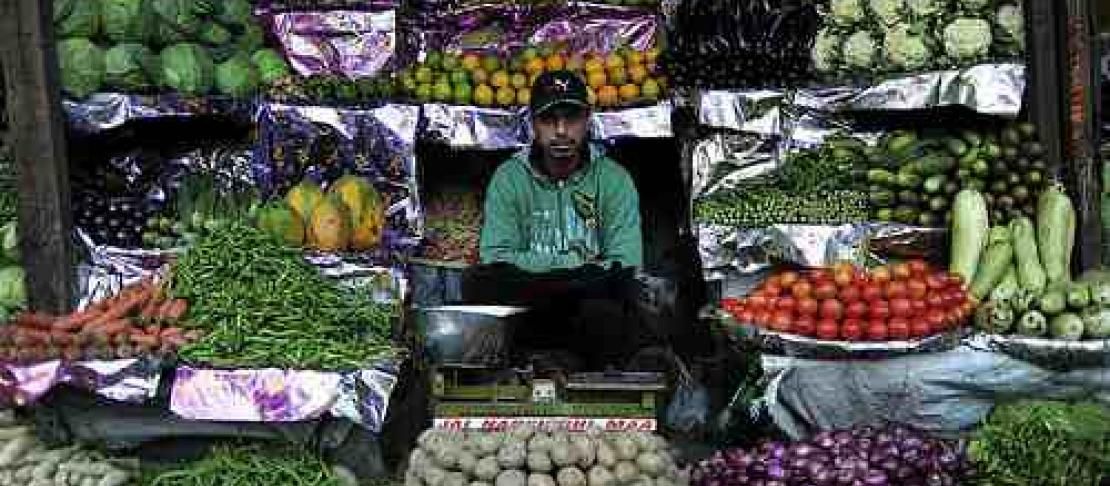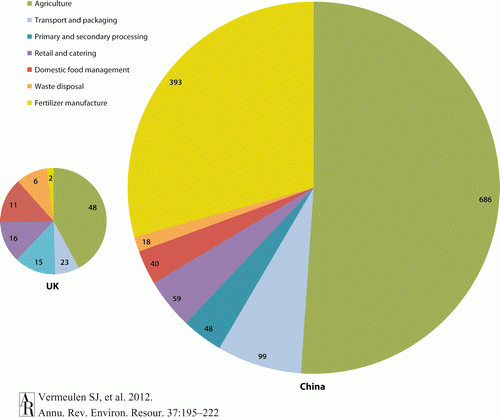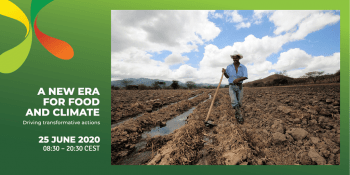Is eating local good for the climate? Thinking beyond food miles

by Bruce Campbell
Agriculture and food production contribute up to 29 percent of global greenhouse gas (GHG) emissions, according to a recently published analysis that made headlines last week.
But where do these figures come from, and what does this mean for reducing the emissions footprint of food production?
A study I co-authored, Climate Change and Food Systems, published in the 2012 Annual Review of Environment and Resources takes a ‘food systems’ approach to calculating emissions that account for every aspect of food production and distribution. This includes the direct emissions of growing crops and raising livestock; the indirect emissions of food production due to land cover change; manufacturing fertiliser; and storing, transporting and refrigerating food.
We found that agricultural practices themselves account for around 80 percent of these emissions, but the combined contribution of transport, refrigeration, consumer practices and waste management is growing, as economies develop. In the UK, for example, emissions from agricultural practices are currently about 40 percent of the total food systems emissions

In many countries, the concept of reducing food miles has caught on with consumers, and food retailers and restaurants are scrambling to provide customers local, ‘climate-friendly’ alternatives to imported foodstuffs. But is this really enough?
As the research shows, the distance food travels from the farm to your plate is only part of the overall emissions equation. Instead we should be looking at everything that happens “from fertiliser to fork” according to Sonja Vermeulen, lead author and head of research for the CGIAR Research Program on Climate Change, Agriculture and Food Security (CCAFS).
Global and national solutions
A key entry point for cutting emissions from food systems is reducing the contribution of agriculture to deforestation. We must support globally coordinated efforts that reduce deforestation, which is often driven by expansion of farmlands. The United Nations Framework Convention on Climate Change (UNFCCC) has recognised how deforestation contributes to global GHG emissions, and since 2010 has backed a program on Reducing Emissions from Deforestation and Forest Degradation.
This program, known by the acronym REDD+, creates incentives for practices that enhance carbon stocks in forests. But our research has found that many countries implementing REDD+ have taken few active steps to address agriculture’s role in continued deforestation. And our research emphasises that agriculture needs to be taken more seriously in deforestation policies if emissions are to be reduced.
Stepping back, it is clear that we need a long and hard look at the whole food chain on a country-by-country basis to understand where GHGs can be reduced at the least cost.
Early this year, the Commission on Sustainable Agriculture and Climate Change published its recommendations on transforming the food system in a changing climate. Their assessment of mitigation opportunities across the food system found three key areas where action is needed:
- Changing consumption patterns: essentially reducing consumption of products with high GHG footprints, e.g. meat.
- Reducing waste in all steps of the food chain, from post-harvest losses (more common in poor countries where transport is inefficient and refrigeration is a luxury) to pre-and-post consumer losses (mostly in rich countries).
- Improving efficiency of production through sustainable agricultural intensification. This includes adopting methods where less nitrogen and methane is emitted per unit of food produced.
Calculating our food’s footprint ‘from fertiliser to fork’
If food miles are only part of the equation, then a full analysis for one commodity would include, among other factors, emissions from fertiliser, costs related to heating greenhouses, and transport and refrigeration. And finding low-cost opportunities to reduce greenhouse gas emissions from the food chain sometimes produces counter-intuitive results.
In an interview with Reuters last week, I mentioned an earlier study that found that for some commodities, including lamb, “emissions were lower when produced in New Zealand and transported by sea to the United Kingdom than when produced in the United Kingdom.” For certain commodities, the researchers found that New Zealand agriculture is that much more efficient in terms of GHG emissions.
We have not yet looked beyond the tip of the iceberg when it comes to the emissions footprint of our food. We need an intensive research effort that studies the different food commodities in different contexts; only then can we truly understand where reductions are possible and feasible.
Read more…
- Vermeulen SJ, Campbell BM, Ingram JSI. 2012. Climate Change and Food Systems. Annual Review of Environment and Resources. 37(195-222). DOI: 10.1146/annurev-environ-020411-130608. Complementary one-time access link to the article
- Kasterine A and Vanzetti D. 2010. The effectiveness, efficiency and equity of market based and voluntary measures to mitigate greenhouse gas emissions from the agri-food sector. UNCTAD Trade and Environment Review
- Beddington J et al. 2012. Achieving Food Security in the Face of Climate Change: Final Report from the Commission on Sustainable Agriculture and Climate Change.
- Kissinger, G. 2011. Linking forests and food production in the REDD+ context. CCAFS Policy Brief 3. Copenhagen, Denmark: CCAFS.
Dr. Bruce Campbell is Director of the CGIAR Research Program on Climate Change, Agriculture and Food Security. Follow him on twitter: @bcampbell_CGIAR


